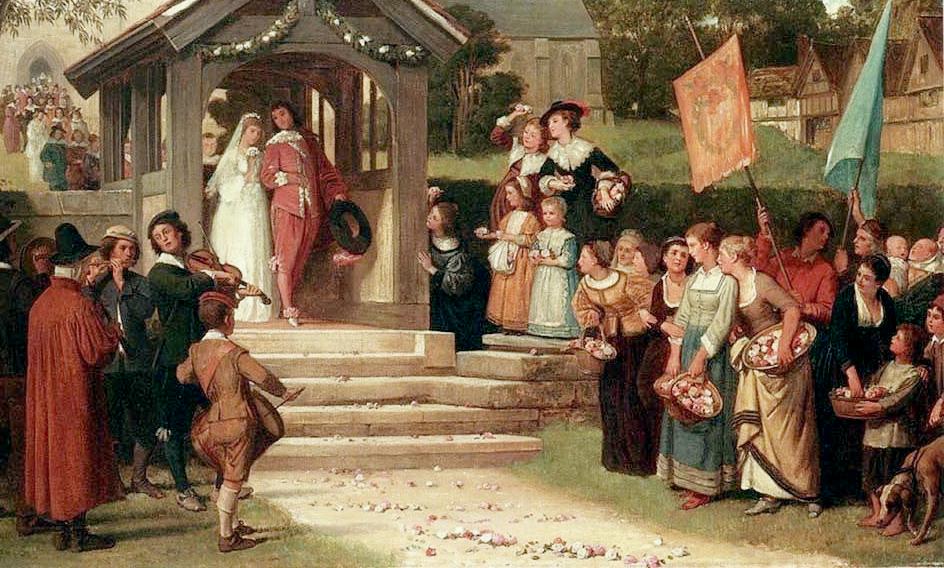
Figure 1.-- This Yeames painting is 'The path of roses'. It is s idedalized wedding scene depicting a 17th century wedding. Note the drummer boy and the midens ready to throw out the baskets of wedding pedals. |

|
William Frrederick (W.F.) Yeames was one of the most popular and renowned Victorian artists. Yeames was born in 1835. He was the son of a wealthy British diplomat. william displayed artistic talents at quite a youthful age. His parents encouraged his interest in art as a young boy. The family began an extended toured Italy in 1841 when William was 6 years old, in part to expose him to the work of the Italian masters. While still in Italy, William's father died in 1842. The family then went to live in Dresden. William was tutored at home with special attention given to artistic studies. William in while only 13 years old moved to London. There he studied under a noted sculptor, Westmacott, as well as George Scharf. After his studies in London, William again traved in Italy. His first exhibit at the Royal Academy after is return to England during 1854. His traditional style and heroic historical subjects made him very popular with the English establishment. He became ARA in 1866 and was elected RA in 1878, and finally Librarian at the Academy. He held many other offices such as Curator of the Painted Hall at Greenwich. One of his more notable paintings was a Civil War scene, "Where did you last see your father?" Yeames died in 1918.
William was the son of a wealthy British diplomat.
W.F. Yeames was born in 1835. Stangely for an English artist, William was born in of all places, Tagenrog near Odessa along the Black Sea in Southern Russia. His father was the British Consul there. In fact Willian did not begin to live in England until a young teenager. He displayed artistic talents at quite a youthful age. His parents encouraged his interest in art as a young boy. The family began an extended toured Italy in 1841 when William was 6 years old, in part to expose him to the work of the Italian masters. While still in Italy, William's father died in 1842. The family then went to live in Dresden.
William was tutored at home with special attention given to artistic studies. William while only 13 years old moved to London in 1848. There he studied under a noted sculptor, Westmacott, as well as George Scharf. After his studied in Dresden and London, William in 1852 again traved in Italy and lived there until 1858. He spent much of his time in Italy at Florence.
William Frrederick (W.F.) was one of the most popular Victorian artists. His first exhibit at the Royal Academy after is return to England during 1859. Yemes was one of the St John's Wood Clique, which included G A Storey, P H Calderon, and D W Wynfield. The St. John's Wood Clique was noted for large canvases depicting dramatic historical or literary scenes. Yeames traditional style and heroic historical subjects made him very popular with the English establishment. He became ARA in 1866 and was elected RA in 1878, and finally Librarian at the Academy. Yeames taught in the RA Schools for many years. He took a real interest in the students and was popular with them. Yeames held many other offices such as Curator of the Painted Hall at
Greenwich.
Yeames specialized in historical and genre pictures which were very popular in Vicorian England. He focused on work with a strong historical and narrative content. The Victorians loved such melodrama. And Yeames especially liked to paint dramatic historical scenes set in historical times. He painted in a realistic style suggestive of genre painting and lived into the period during which
impressionism became the fashionable style, so that he was considered very old-fashioned during this latter days. He loved scenes that were highly emotional and dramatic and that appealed to sentiment. He has been accused of sentimentality.
This is one of the most pathetic scenes in Shakespeare - Arthur's appeal to Hurbert. "Will you put out mine eyes - these eyes that never did, nor never did, nor never shall, so much as frown on you?" It is from the painting by W.F. Yeames, R.A., now hanging in the Manchester Art Gallery. It is a typically dramatic Yames painting.
Perhaps his best known painting is "And When Did You Last See Your Father? (Walker Art Gallery, Liverpool). The painting is an English Civil War scene which shows threatening Cromwellian soldiers grilling a brave little Royalist boy. The boy has been placed on a stool surounded by soldiers in dark clothes. The gallant Roylist boy is dressed in a light blue satin suit and thus stands out among the dark figures of the soldiers. The image shown here is a dramatic scene from Shakespere's "King Jphn" (figure 1).
Yeames was extremely popular in his era. The very realism and histrionics of hisart was a perfect example of the work that the Pre-Raphaelites objected to. An of course the impresionists rejected it even more strongly.
Yeames married a daughter of Major Wingfield and a nice of RA member Sir David Wilkie.
The increasing popularity of the impressionists by the late 19th century made Yeames art look old fassioned. Yeames died in 1918 many year after the peak of his career, the Times obituary noted " at one time a very popular artist".
Obituary, The Times (London), May 8, 1918.
Navigate the Boys' Historical Clothing Web Site:
{Return to the Main English artist page]
[Return to the Main individual S-Z artist page]
[Return to the Main individual artists page]
[About Us]
[Introduction]
[Activities]
[Biographies]
[Chronology]
[Clothing styles]
[Countries]
[Girls]
[Theatricals]
[Bibliographies]
[Contributions]
[FAQs]
[Glossaries]
[Images]
[Index]
[Links]
[Registration]
[Tools]
[Main HBC Topic page]
[Boys' Historical Clothing Home]
